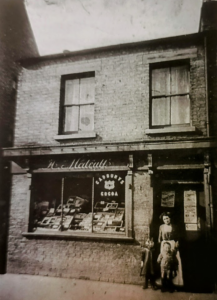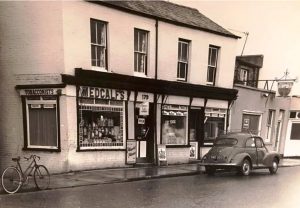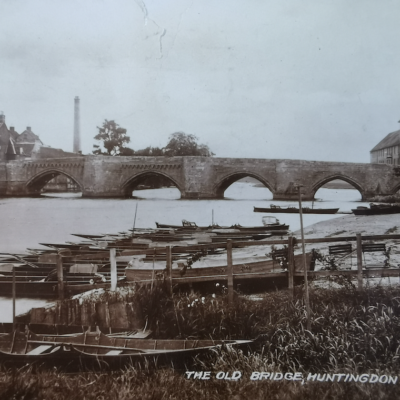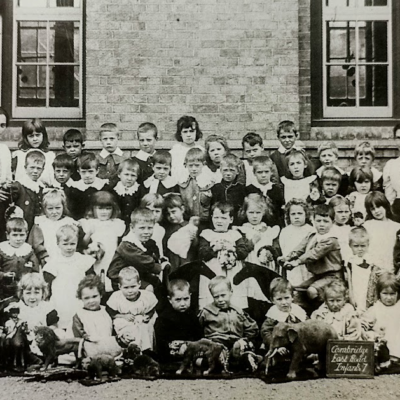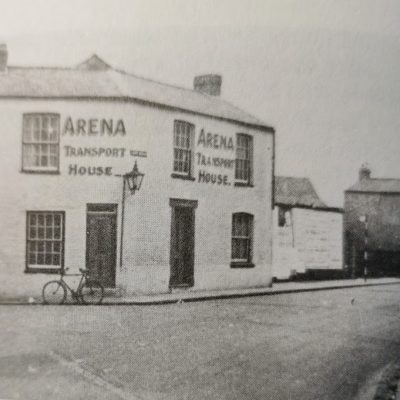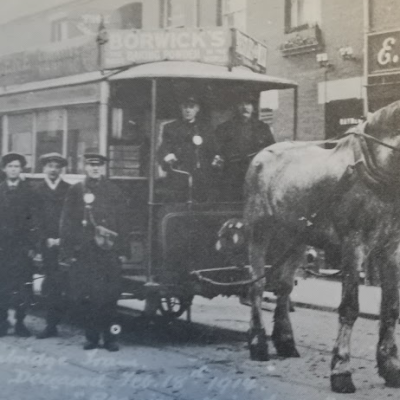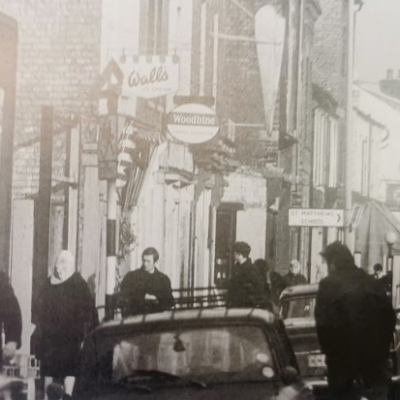Search by topic
- archaeology
- Building of Local Interest
- charity
- church
- crime
- dressmaker
- fire
- Great Eastern Railway
- Listed building
- Mapping Relief
- medieval
- oral history
- poverty
- Public House
- Rattee & Kett
- Religious House
- Roman
- scholar
- school
- Then and Now
- tudor
- women
- work
- world war one
- world war two
Search by text
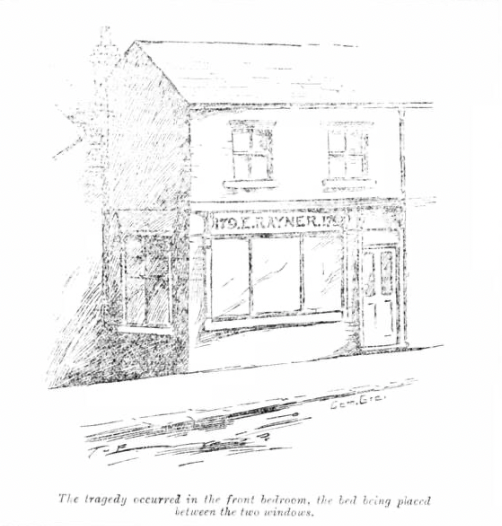 179 East Road, (CDN 21.11.1900)
179 East Road, (CDN 21.11.1900)179 East Road
History of 179 East Road
1900 CDN 21.11.1900: Horrible Tragedy At Cambridge This Morning Three Children Murdered. Mother’s Supposed Suicide. Lodger’s Fearful Discovery. Details of the Crime. Six Poison Phials Discovered. Important Interviews. Cambridge was this (Wednesday) morning plunged into a state of consternation and horror by report that a woman and her three children, living at East-road, had been discovered in their bedroom with their throats cut. With that rapidity which usually characterises the rumour of a dreadful tragedy the news spread to all parts of the borough, and when at length the report was confirmed the profoundest feeling prevailed. The scene of the occurrence was small general shop at East-road, occupied by a Mrs Emma Rayner and her three children, whose ages ranged between four and nine years. Mrs Rayner herself was a woman of about 32 years of age. The dead bodies were discovered by a lodger about half-past eight this (Wednesday) morning under peculiar circumstances. The lodger who is a carpenter employed by Mr Banyard of Gwydir Street, as was his custom, left the house at an early hour. At the time indicated he returned to breakfast. The meal to his great surprise had not been prepared and to his further astonishment there was no fire. As neither Mrs Rayner nor her children were on the move he naturally concluded that the landlady had overslept, and accordingly he proceeded to her bedroom. He knocked at the door but got no answer. Apprehensive that something unusual had happened, he opened the door and his horror may be imagined when he saw the dead bodies of Mrs Rayner and her three children—a boy and two girls—lying covered with blood on the bed. Greatly terrified at the appalling spectacle, he ran at once into the house of a neighbour, Mr Coulson, and apprised him of the dreadful tragedy. Not a moment was lost in communicating with the police, and meanwhile a messenger was sent to summon Dr Greer. As soon the police officer and the doctor arrived Mr Coulson and the lodger accompanied them to the room where the bodies lay, and upon examination it was found that the woman and her children met their death under most distressing and painful circumstances. The position of the bodies on the bed was remarkable. The room was well furnished considering the unhappy woman’s station in life, and the bedstead stood in the centre between the two windows overlooking East-road. At the head of the bed lay the body of Mrs Rayner who was attired only in a combination nightdress. She was in a drawn up posture, and at her side, almost on the corner of the bedstead, lay the little boy Gilbert, aged seven years. Curiously Elsie, aged nine years, and Sybil, aged four years, lay at the foot of the bedstead. The poor children, each of whom wore a nightgown, all had the appearance of being asleep. Their throats had been cut in the most determined fashion, and blood had spurted from the wounds and completely saturated the bed clothes. Mrs Rayner’s head was almost severed from the body, and a razor was embedded in the wound in her throat. A more ghastly spectacle than the lifeless forms of a mother and her family in such a condition can hardly be imagined. There was no evidence whatever of a struggle, but the whole circumstances of the sad occurrence support the view that Mrs Rayner first took the lives of her three children, and then herself committed suicide. Whether the children were put to bed on Tuesday night is quite an open question. With regard to the boy Gilbert, there is reason to believe that at the time the fatal wound was inflicted upon him he was asleep. The girls, who were lying at the foot of the bed, were, however, uncovered by the bedclothes. It may be inferred from this and the fact that no alarm was given or heard that something had been administered to the children in order to stupefy them. Be that as it may it is difficult to conceive how such a crime could have been perpetrated in absolute silence. Whether or not this supposition has any foundation in fact could of course only be ascertained by means of post mortem examination but seeing that beyond any shadow of doubt the primary cause of death was the wounds in their throats such an examination is considered be a superfluous. The woman’s right hand was covered with blood, but there were no blood stains in any other part of the room except the bed itself. There is every reason therefore, for believing that the children were all murdered in the bedroom, and while lying on the bed. When found the unfortunate victims had been dead several hours, so that the crime was, doubtless, enacted in the dead of the night, when, in all probability, any alarm that might have been given would not have been heard either by the lodger or the neighbours. From enquiries made in the neighbourhood, it has been ascertained that Mrs Rayner had occupied the house and shop for about three weeks, and that was some few days after that that she commenced business as a toy and sweetstuff dealer. Tuesday was Mrs Raynor’s washing day, and the neighbours were informed by a woman who was at work at the house that Mrs Rayner was not very well, and that she feared she had an attack of influenza. In the evening the shop was closed earlier than usual, and Mrs Rayner spoke to neighbours of going into the town for the purpose of obtaining something for her cold. Neither Mrs Rayner nor her children were again seen alive, though half-past ten at night Mrs Abbs, a neighbour, saw a light in Mrs Rayner’s sitting room. Formerly the deceased woman lived apart from her husband at 55, Catherine street, Romsey Town. She went there upwards of two years ago, and during the whole time had the good opinion of her neighbours, who speak of her as a highly respectable, hard-working woman.
LATER DETAILS. Six Poison Phials Found In The Bedroom. Information obtained later serves to substantiate the theory of poison having been administered before the throats were cut. When the bodies were found it was noticed that the legs of all the victims were drawn up. On the right side of the bed was a tea cup and a glass tumbler. A flat liquor bottle, which had evidently con- both of which smelled strongly of peppermint, -tained brandy, was also found. In a small hand basket, standing on a writing case, which was placed upon a table near the left-hand window, there were five small phials, all empty and labelled “Laudanum- poison.” These labels, which were of a red hue, bore the names of “H. J. Church, 18, St. Andrew’s-street,” “Boots, Cash Chemists, Petty cury,” “A. A. Deck, Theatre Pharmacy, St. Andrew’s-street,” “A. Deck, chemist. King’s-parade,” and “J Yeomans, Petty cury.” In the same basket were two small phials, labelled “Essence of peppermint,” one bearing the name of H.J. Church, and the other J. Yeomans. On the wash stand was small phial containing a dark fluid, labelled “Ear drops— poison”.
Mrs. Rayner purchased some laudanum at the Theatre Pharmacy on Tuesday evening, between seven and eight o’clock. Mr. Deck himself supplied the drug, which Mrs. explained was for the toothache. She was advised to take a bottle of neuralgic mixture, but she insisted having laudanum, remarking that that was the only thing that gave her relief. The woman seemed perfectly rational, and conversed quite coherently with Mr. Deck for several minutes. The quantity of poison she obtained from Mr. Deck was twopennyworth (two drachms). It was earlier in the evening that she went to Mr. Deck on King’s parade on a similar errand. Here she asked for threepennyworth of laudanum. Mr. Deck advised the woman to have something else. Mrs. Rayner explained that her teeth were causing her great pain, and the woman appeared to be very distressed. Mr. Deck supplied Mrs. Rayner with 1d. worth only of the drug. Leaving this shop, the woman must have proceeded down Petty cury where she made other purchases. At Boots she obtained threepennyworth of essence of peppermint and an ounce of laudanum, the latter which she said was for face ache. Her next call was at Mr. Yeomans, in Petty cury. As at Mr. Deck’s, St. Andrew’s street, she was advised take a bottle of mixture in preference to the laudanum, as she said she was suffering from neuralgia. Nothing but laudanum would suffice, however, and she took away threepennyworth. Some few days previously we have ascertained the unhappy woman obtained a similar quantity laudanum at Mr. Church’s. St. Andrew’s Street.
The Lodgers’ Narratives. Strange Incident in the Night. “Where are My Children?” The lodger alluded to above, whose name is Henry William Claxton and who is a carpenter, working for Banyard, Gwydir-street, told the following story :
“I have been lodging with Mrs Rayner. I got up this morning about eight o’clock and went to work. I returned about nine, and I could not see Mrs Rayner about. I went upstairs and knocked at the outer bedroom door. One has to pass through this room to get into Mrs Rayner’s room. The door was closed and I knocked several times and then called out “Mrs Raynor” several times. As I still could get no answer I opened the door, and I saw that the door of Mrs Rayner’s room was open. I again called ’’Mrs Rayner,” but no answer came from either her or the children. I stepped into the doorway and saw Mrs Raynor with her three children lying uncovered on the bed smothered with blood, and all their throats appeared to be cut. I immediately ran out and sent for Dr Greer, and went myself and gave information to P.C. Clark. I slept in the back bedroom on Tuesday night. John Dellar, my fellow lodger, being in the same bed. I heard no unusual noise during the night. I heard Mrs Rayner come downstairs about 11.30 p.m., and heard her come up again about 10 minutes later. I have never heard her express any desire as regards suicide. She complained several times of pains in the head. Last Saturday I gave her notice to leave. She replied, “I am very miserable. and now there is that.”
John Cellar. Mrs Rayner’s other lodger, said – “I am a butcher in the employ of Mr Coulson, East-road. I have been lodging at 179, East-road. At 10.30 on Tuesday night I was in bed when the little girl Elsie came up and woke me up. She said “Mother is not well, and won’t wake up.” I told her I would come and see what was the matter. I got up and dressed, and went into Mrs Raynor’s room. She was lying in bed with her head hanging out. The little girl Sybil was in bed with her. Elsie and the boy Gilbert were lying on the floor. Mrs Rayner was breathing heavily. I tried to rouse her. After a time she suddenly sprang up, sat up in bed, and said “Where are my children?” I said “They’re lying on the floor.” She said “Will you put them in bed for me?” I put the boy in the bed and Elsie in the crib on the left side of the bed. The boy asked for his playthings, and I gave them to him. I said to Mrs Rayner “Shall I fetch a doctor to you?’’ and she replied “No, don’t; I feel ever so much better now. You had better go and get in bed and go to sleep. I shall be all right.” I then left the room. I noticed a strong smell of peppermint. I heard no unusual noise during the night. I heard Mrs Rayner go downstairs about halfpast eleven, but did not hear her come back. I have heard her complain of headache. I have not noticed anything strange about her.”
Interviews with Neighbours. HOW THE BODIES WERE FOUND. Mrs. Rayner’s Struggle for Existence. Mrs Rayner having lived in East-road such a short time, the neighbours knew but little about her. In conversation which a Cambridge Daily News representative had with several residents one sentiment was general. Everyone spoke in terms of respect of the deceased woman, and of admiration for her industry and hard struggle to maintain herself and her children in spite of many adverse circumstances. The impression is that she struggled with poverty and other troubles so long as she could, but her strength proved not sufficient for the load she had to bear, and she therefore chose this shocking means of ridding herself of the cares of life.
Mr. A. A. Coulson, hatter and clothier, whose shop is separated from the premises where the tragedy took place by a narrow passage, was the first to acquainted by the lodger of what had taken place. He was opening his shop a little before nine o’clock, when he was startled by the lodger coming to him in state of excitement and telling him that Mrs. Rayner had cut her throat. The story of the lodger was that he had came home to breakfast about half-past eight, and was surprised at finding nothing ready. He went to Mrs. Rayner’s bedroom door and knocked, but received no answer. On looking into the room he was horrified at seeing the woman and children all in sleeping attire lying on the bed with their throats cut. Mr. Coulson sent for a policeman, and despatched a note to the Chief Constable, while the lodger sent for Dr. Greer. The doctor, policeman, lodger, and Mr. Coulson went into the room where the bodies lay.
It was something like a scene in the Chamber of Horrors at Madam Tussaud’s,” said Mr. Coulson when asked what appearance the bedroom had. “The children were apparently in bed and asleep when they had their throats cut,” he continued. “They were all in nightdresses, and the woman had on a kind of combination sleeping dress. The little boy lay next to the woman, face downwards. and the two girls were at the foot of the bed. The woman was lying on her back, and her head appeared to be almost severed from her body. Blood was sprinkled about all over the place. The room was tidily arranged, and everything was clean and nice.”
“Had you taken any notice of Mrs. Rayner’s habits during the time she lived there,” asked the reporter.
“She has been a very hard-working little woman,” replied Mr. Coulson emphatically. Since she has been living here she has been doing her best to get a living. No one could have tried harder. When she put a card announcing the lodging to let a short time ago the thought passed my mind that she was determined to leave no stone unturned. ”
Mrs Abbs, who carries on the business of a harness maker &c in the shop adjoining that of the deceased woman, was probably the most intimate of any neighbour with Mrs. Rayner. The latter, Mrs. Abbs said, was a quiet, reserved woman, making but few friends.
‘’We used to wish each other ‘Good morning’ and so on,” said Mrs. Abbs, “and her children were always here playing with mine. The children were Elsie (aged nine) Sybil (aged four), and Gilbert (aged seven). Mrs. Rayner came to live next door about three weeks or a month ago – she came a Wednesday—and I thought what a nice, quiet neighbour she was. On Tuesday she had woman to do washing for her and the washerwoman said Mrs. Rayner was notwell, and that she thought she had a touch of influenza. In the evening she said she was going to take the children down to the town to get something for her cold, and the shop was closed much earlier than usual —about five o’clock. The little boy always came go out in our pony trap after tea but last night didn’t come. When I went to bed at half-past there was a light Mrs. Rayner’s sitting room, but I did not hear any body about, nor did I hear her go upstairs, I generally did. This morning I noticed she was not up quite so early usual. She was a very pleasant spoken woman, and I know was a hardworking woman. She was always clean and industrious and the children were extraordinarily clean.”
MRS. RAYNER’S LIFE AT CATHERINE STREET. Domestic Trouble. In an interview with Mrs. Robinson, who lives at No. 53, Catherine-street, [Catharine Street] a representative of the “Cambridge Daily News” learned something of Mrs. Rayner’s antecedents.
“She was good neighbour.” said Mrs. Robinson ” and” she added ”I cannot believe she killed her dear Iittle children. She was not a woman of that sort. Mrs. Rayner came to live here two years ago last August, and have seen a good deal of her.’’
“Yes, she was married, and her husband is still living. Some years ago Mr. Rayner carried on the business of a baker at Trumpington. but for some reason or other I have never quite been able understand why he left Trumpington and about the same time he went away.”
“Had Mrs. Rayner any domestic trouble?”
“Of course she felt it very much when her husband left her but he continued to send her money down to last August, since which time she had heard nothing of his wherabouts and she could get no tidings of him, though she went to considerable trouble and some expense to do so in order to compel him to contribute towards the maintenance of her three children.”
“Oh yes she had a very comfortable home indeed, and her children were well clothed and cared for. She was unable entirely to support herself means of her lodger, but she had a little money by her and so was able for a time to eke out an existence. In her struggle to keep her head above water she was helped by her father, who is a stationmaster near Yarmouth, and also her brothers and sisters, who frequently sent her small sums of money.”
“How came Mrs. Rayner to leave Catherine street ?”
“Well you see, she was get a living here, and she thought that if she could get a shop she might be able make a living. In starting in business she had the assistance of her father. The deceased left here three weeks ago to-day Wednesday.”
1913 – 1937 Harry Medcalf, confectioner
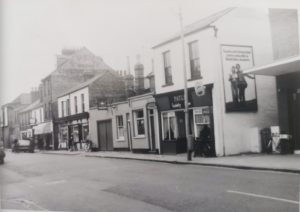
179 East Road, March 1974 (MoC 607/74) Left to right: Old tram depot, Cambridge Resale no.182, Auscott’s rest., Carter Electrical, alley, Medcalf’s sweet shop no.179, two bars of the Bakers Arms, Paul Variety Fare, Hardy and Co.
Contribute
Do you have any information about the people or places in this article? If so, then please let us know using the Contact page or by emailing capturingcambridge@
License
This work is licensed under CC BY-NC-SA 4.0





